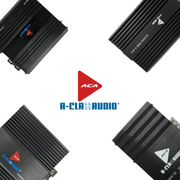Installing a high-quality audio system in a car is a quest for many music enthusiasts. At the heart of this quest is the amplifier, an essential component that can transform your in-car listening experience. This article explores the key features to consider when purchasing a car audio amplifier.
1. The Power of the Amplifier
Power is arguably the most crucial characteristic of an amplifier. It is usually measured in watts RMS (Root Mean Square), which indicates the continuous power the amplifier can deliver without distortion. Higher wattage generally means clearer and louder sound. Here are some key points to remember:
- RMS power vs. Max Power : RMS power is more important because it represents the real performance of the amplifier, while max power is often just a marketing argument.
- Speaker Compatibility : Make sure the amplifier wattage matches that of your speakers to avoid potential damage.
2. The Number of Channels
Amplifiers are available in different channel configurations, and the choice depends on your audio system configuration:
- Mono (1 channel) : Ideal for subwoofers.
- 2 Channels : Perfect for powering two front speakers or a subwoofer in bridged mode.
- 4 Channels : Suitable for powering four speakers or two speakers and a subwoofer.
- 6 Channels or More : For more complex installations with multiple speakers and subwoofers.
3. Amplifier Classes
Amplifiers are classified into different categories (A, B, AB, D, etc.) depending on their design and efficiency:
- Class A : Offers exceptional sound quality but is less efficient and produces more heat.
- Class B : More efficient than Class A, but with slightly lower sound quality.
- Class AB : Combines the advantages of classes A and B, offering a good compromise between sound quality and efficiency.
- Class D : Very efficient and compact, perfect for subwoofers, but may have slightly lower sound quality for high frequencies.
4. Signal-to-Noise Ratio (SNR)
The signal-to-noise ratio measures the level of background noise produced by the amplifier in relation to the audio signal. High SNR (expressed in decibels, dB) means less background noise and better sound quality. An SNR above 90 dB is generally considered good.
5. Total Harmonic Distortion (THD)
THD measures the level of distortion introduced by the amplifier into the audio signal. A low THD is desirable for faithful sound reproduction. High quality amplifiers will have a THD of less than 1%.
6. Filter Settings
Modern amplifiers are often equipped with various filter settings to fine-tune sound quality:
- Low Pass Filters (LPF) : For subwoofers, allowing high frequencies to be blocked.
- High Pass Filters (HPF) : For speakers, blocking low frequencies.
- Band Pass Filters (BPF) : Allow you to target a specific frequency range.
7. High/Low Level Entry
High and low level inputs allow the amplifier to connect to different audio sources:
- Low Level Input (RCA) : Used for connections with high quality head units.
- High Level Input : Used for connections with stock head units without RCA outputs, converting speaker signals into signals compatible with the amplifier.
8. Cooling and Heat Management
A good cooling system is crucial to prevent the amplifier from overheating. Look for amplifiers with efficient heat sinks and built-in fans to maintain optimal performance.
Conclusion
Choosing the right amplifier for your car audio setup can transform your listening experience. By considering power, number of channels, amplifier class, signal-to-noise ratio, total harmonic distortion, filter settings, input types and heat management, you can find the perfect amplifier to meet your needs and preferences. Take the time to understand these features to make an informed choice and take full advantage of your car audio system.





